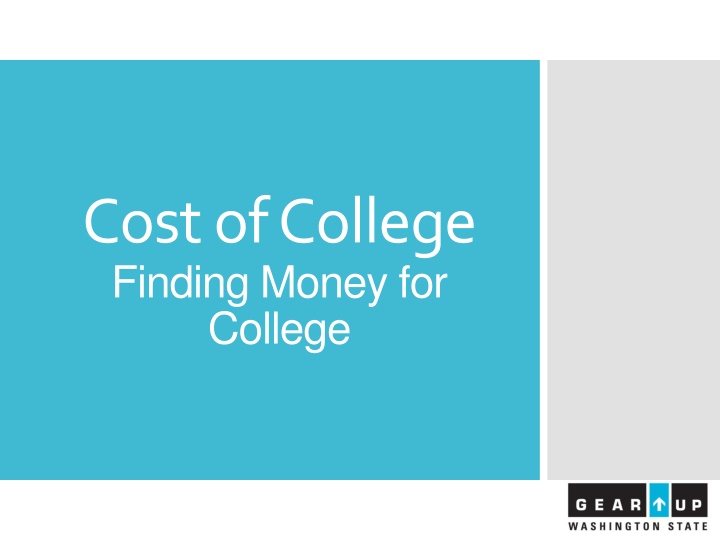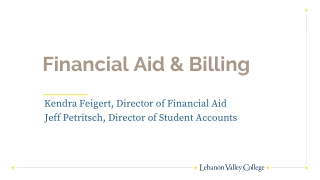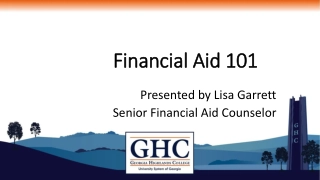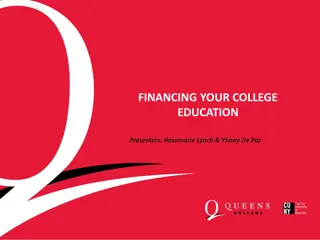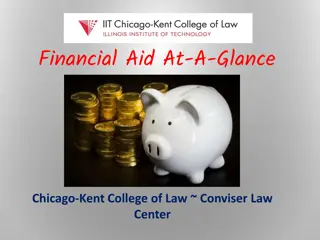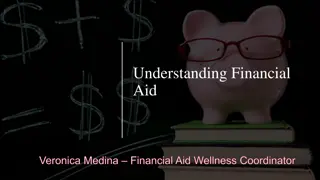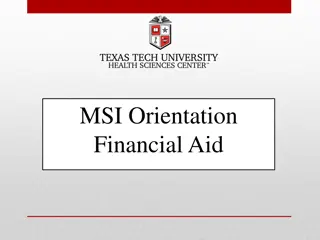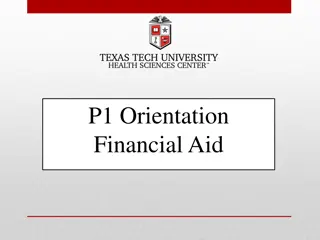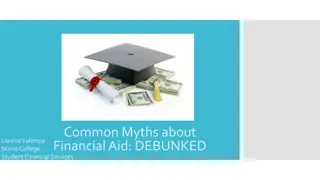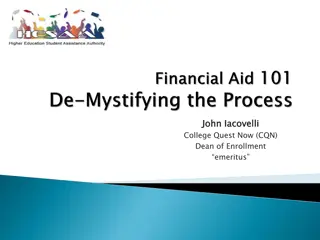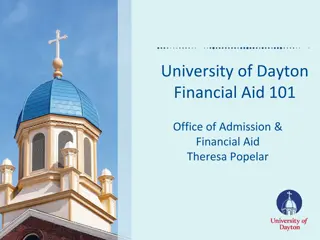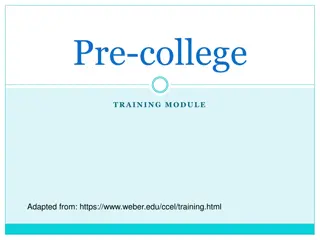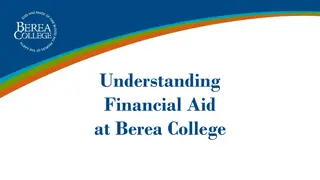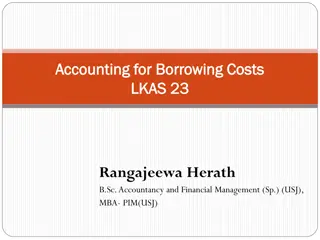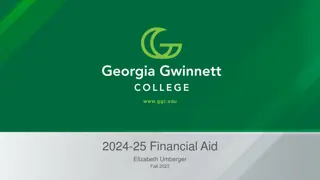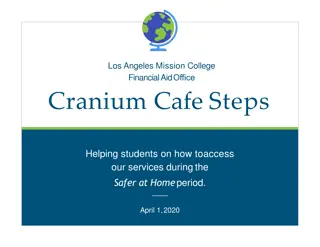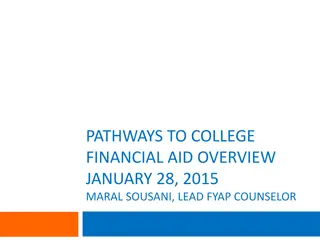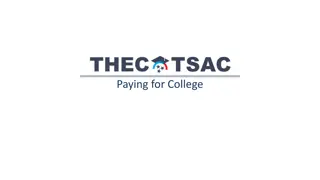College Costs and Financial Aid
College costs vary based on expenses like tuition, fees, room and board. Learn about financial aid sources such as grants, work-study, loans, and scholarships to help pay for education. To qualify for aid, complete the FAFSA or WASFA annually.
Download Presentation

Please find below an Image/Link to download the presentation.
The content on the website is provided AS IS for your information and personal use only. It may not be sold, licensed, or shared on other websites without obtaining consent from the author.If you encounter any issues during the download, it is possible that the publisher has removed the file from their server.
You are allowed to download the files provided on this website for personal or commercial use, subject to the condition that they are used lawfully. All files are the property of their respective owners.
The content on the website is provided AS IS for your information and personal use only. It may not be sold, licensed, or shared on other websites without obtaining consent from the author.
E N D
Presentation Transcript
Cost of College Finding Money for College
Introductions Our GEAR UP Team includes:
oWhen we say college, we mean any type of education or training after high school. We also use the terms postsecondary education and postsecondary training . oThere are many options for students after high school, including apprenticeships, military, on-the- job training programs, community college certificates, two-year degrees, and four-year degrees. oThe term college includes all of these things. What do we mean when we say college?
The value of a degree
College costs are different at different schools. Each college estimates the Cost of Attendance (COA) by adding together some or all of the below expenses: Tuition How much does it cost? Fees Room and board Transportation Books and supplies Other living expenses
Live at home. Rent an apartment alone or with friends. Live in a dorm on campus. Room and board options
Transportation. Personal. Recreation. Additional costs
Most people use various sources of financial aid to pay for college in addition to any savings they may have set aside. Financial aid is money to pay for college or career school and it can include the following: Grants. Work-study. Loans. Scholarships. How do I pay for it?
In order to be considered for financial aid, you need to complete the FAFSA or the WASFA your senior year and every year you go to college. Each college determines financial aid eligibility for federal, state and institutional types of aid based on awarding policies at that campus. How does someone qualify? Free Application for Federal Student id Washington Application for State Financial Aid FAFSA.gov Readysetgrad.org/wasfa
Applying for aid usually takes about half an hour. Determines families ability to contribute to cost of attendance. How much financial aid can I get? In general, depends on your financial need. COA is tuition, fees, room and board, transportation, etc. COA EFC = financial need
How much will a student pay?
The College Scorecard is available on the Department of Education s website. This tool takes all schools in the country which accept federal funding (federal student loans) and allows them to be easily searched in one place College Scorecard The tool allows students to select majors, states, size of the institution, even school mission and religious affiliation. collegescorecard.ed.gov
Comparison Shop: College Navigator Resources on this website are also available in Spanish
Comparison Shop: Net Price Calculator
Comparison Shop: College Cost Center AVAILABLE AT: College Affordability and Transparency Center
Early commitment of state financial aid to eligible 7thand 8thgrade students who apply by June 30thof 8thgrade. What is the College Bound Scholarship? Combines with other state financial aid to cover the average cost of tuition (at comparable public college rates), some fees, and a small book allowance = commitment. Can be used at over 60 two- and four-year public and private colleges and universities.
Students must meet one of the following requirements during 7th OR 8th grade. Who can apply? Student is a foster youth, at any point in time between grade 7 and age 21. Family income meets the minimum on the MFI Chart. Student s family receives TANF benefits.
College Bound is a Two Step Process Apply in 7th or 8th grade, by June 30 of 8th grade year (foster youth are auto-enrolled). Meet income requirements; verified on the application. Foster Youth are auto-enrolled if they are in care at any point in time from grade 7 to age 21 Step One Step Two Fulfill the College Bound Pledge. Meet income requirements; verified by the college using information from FAFSA or WASFA. Be accepted to and attend an eligible college within one year of graduating high school.
Graduate from a Washington State high school with a 2.0 GPA or better. Have no felony convictions. Be income eligible, determined by the college with information from the FAFSA or WASFA. Enroll in an eligible college within one year of high school graduation. Students can use up to four years of the scholarship within five years of high school graduation. The Pledge
Must enroll in college within 1 year of high school graduation, 1 earned credit meets this requirement. Must be used within five year of HS graduation (Class of 2018 s CB scholarship expires in 2023). Maintaining Eligibility Remain in good standing with your college to maintain scholarship (GPA, honor code, etc.). File the FAFSA or WASFA early every year in college. Ineligible one year? File the next year - Income eligibility assessed each year of college.
That the cost of tuition at public rates, some fees and a small book allowance will be covered by state financial aid. College Bound works in combination with other state financial aid (such as Washington College Grant) to cover a students costs for college. Actual amounts for the College Bound Award are based on the type of college the student attends and their tuition rate. What is the Commitment?
Contact information: [insert counselor/advisor/mentor name] Phone: (xxx) xxx-xxxx E-mail: xxxx@xxxx.xxx Thanks for coming
Topic Next Family Night Date
